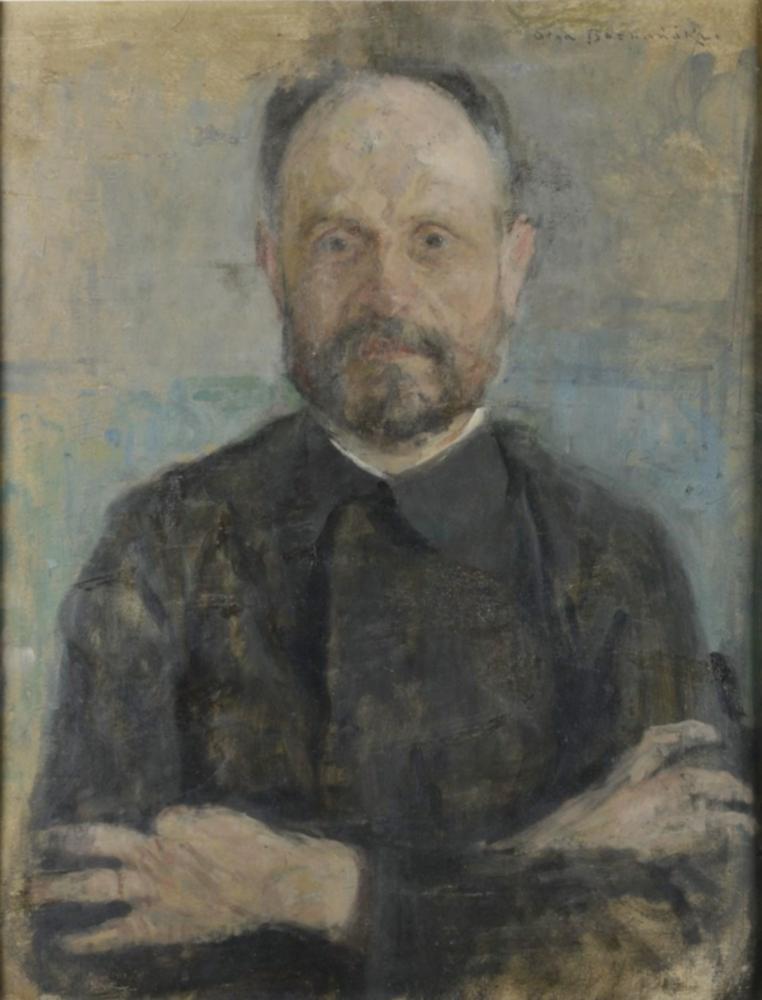Description: This painting is located in the large Hall of the Rogaliński Gallery, alongside other works of one of the most prominent European portraitists, Olga Boznańska (1864-1940). She was introduced to the arcana of art by her French mother, who was an amateur draughtsman. Later she attended classes at the studios of Kazimierz Pochwalski, Antoni Piotrowski, and the Higher Courses for Women of Adrian Baraniecki. From 1886 she studied at the private school of Karol Kricheldorf in Munich, as well as at the studios of Wilhelm Dürra and Paul Neuen. After a short stay in Kraków, she returned to Munich, where she perfected her technique independently. In 1898 she settled permanently in Paris, where she died in 1940. Already during her studies in Munich, she exhibited her works at the Kraków Society of Friends of Fine Arts, as well as at numerous shows in Munich, Berlin, Vienna, and other European cities. Very early recognized, especially abroad, she developed her own, unique style. It had a great influence on the younger generation of Polish artists from the “KP” group, who stayed in Paris in the 1920s and were focused around Józef Pankiewicz. The difference between Boznańska, more appreciated by them, and their Parisian guide Józef Pankiewicz was perfectly captured by J. Wolff, who wrote that “Pankiewicz’s art… is a bridge connecting us to European art, Boznańska’s art is our contribution to that art”.*
Description of the painting:
Angelika Kuźniak, in her latest biography of the artist, perfectly introduces us to the atmosphere of her Paris studio and the backstage of the portraits being created there, including the image of the Krakow philosopher **. Imagine the artist’s cluttered studio on Boulevard Montparnasse 49. In the middle there is a pedestal with a chair on which Professor Wincenty Lutosławski sits, a distinguished scientist, a world-renowned expert on Plato, a spiritual metaphysician, a continuator of romantic philosophy and a propagator of the ethical national revival movement, and also the author of the first Polish publication on yoga ***. On the shelf lie his political writings “La politique nationale”, in which the artist is reading *. However, she is afraid to stay with him alone, as he is known for spreading his metaphysical reflections. She asked her acquaintance, the painter Marcin Samlicki, to “interrogate” the model. However, Lutosławski refused, saying that he would not pose in his presence. When Samlicki visited Boznańska after a few days, she told him that she could not finish the portrait, as Lutosławski was offended by her and no longer came. “At the last session, the professor was especially excited, then I caught his gaze and this sketch was born … but I cannot finish it. In the midst of a terrible silence, my model suddenly asked me: “Do you really know what you should extract from me in the portrait?” I answered something, to which he replied in an irritated tone: “Do you not see the hundred guardian angels standing behind me? ”I laughed and replied casually:“ Well, [but they have to behave calmly, [otherwise] I could not work at all ”. [These words] the professor read to me as blasphemy, he rose and ran away without saying goodbye. ”**
In 1909, together with 30 other paintings, Boznańska exhibits them in this unfinished form at the women’s exhibition – painters at the Le Petit Musée Beaudouin in Paris. The critics recognize it as one of the best**. Boznańska herself writes about them to her friend Julia Gradomska: “[..]My pictures look wonderful, because they are true, they are honest, because they are yours, there is no narrow-mindedness in them, no mannerisms, no flattery. They are quiet and alive and as if a light veil separated them from the viewers. They are in their own atmosphere ”***.
At first glance, Lutosławski’s portrait seems unremarkable and unimpressive. The scientist in black clothes was placed on an unfinished background of warm cardboard, animated by muted green-blue glows of an undefined space. With the barely visible white collar, the white glows of an invisible light source merge, which are painted on the high forehead and eyes of the thinker. We also find strokes of white, blue and green on the hands of the portrayed. Thanks to this, they merge with the general tonality of the image without dominating the black background of the clothes. The warmer face in hue, however, maintains a relationship with the gilded cardboard background, and through the black beard and hair with the dark clothing. The figure creates a homogeneous optical phenomenon with the surrounding space * immersed “in its own atmosphere” contained in the plane of the image.
This portrait is a moving testimony to the skill of creating a suggestive impression of the existence of a person using extremely economical means of expression. But to notice this, as the artist wants, we need to confront the portrayed. Stand in front of him and look him in the eyes. Hence the closeness of the model to the frame of the canvas, hence the frontal and symmetrical frame and the lack of any anecdote in the image. So it is important not only to capture the external resemblance of the model, but to confront him with his spirituality available in his gaze. But also a character revealed in the pose and gesture of the hands, which the artist never interfered with. She watched them closely and tenderly, giving an answer to the question about the model’s relationship to the surrounding reality. In this case, given with the natural harmony of colors of nature, which she used in the background.
Here the truth about the painted model coincides with her ethical and uninvolved approach to art. Boznańska devoted her entire life to this, looking for painting and coloristic means of expression that would be consistent, even emotionally, with the presented theme.


